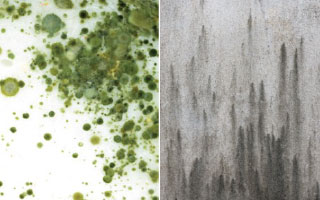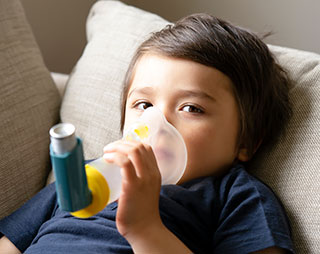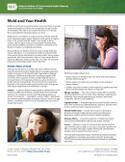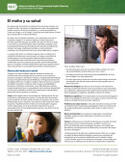Introduction

How do people get exposed to mold?
Mold is a microorganism and type of fungus that thrives in wet places. In nature, it forms on damp materials and in decaying organic matter. Outdoor mold reaches its highest levels in the summer and fall. Inside, it can spread on damp surfaces, like the paper surface of wet drywall. Flooding, leaky pipes, humid conditions, and poor ventilation contribute to the growth of mold in our buildings and homes.
Most molds are not harmful. Some are used to make foods, like cheese and yogurt, or to manufacture medicines, like penicillin. A few species can be detrimental to human health. Some produce mycotoxins, which are substances that can cause severe illness if ingested. Molds also release spores that can irritate the nose and lungs and occasionally produce severe reactions.

Molds and mildews are related, but distinct, types of fungi. Mold (left) tends to be fuzzy, thicker, and greenish or black in color. Mildew (right) is typically powdery and rests flat on surfaces.
What are the most common forms of mold?
According to the Centers for Disease Control and Prevention, the most common indoor molds are:
- Alternaria
- Aspergillus
- Cladosporium
- Penicillium
- Stachybotrys chartarum (also known as black mold)

What are some of the health effects associated with mold exposure?
Allergic reactions to mold spore exposure may include:
- Blurred vision
- Chronic cough
- Eye irritation
- Headache
- Nasal and sinus congestion
- Skin rash
- Sore throat
For some individuals contact with certain molds may produce more serious reactions.
Asthma —Studies have shown that mold exposure can increase a person’s risk of developing asthma or worsen its symptoms — especially for young children.
Cancer — Aflatoxin, a type of mycotoxin found on corn and other grains, seeds, or nut crops, has been listed by the NTP as a human carcinogen.
Cognitive issues — Extended exposure to mold has been linked to short-term memory loss, lightheadedness, dizziness, blurred vision, ringing in the ears, and loss of cognitive functions, also known as “brain fog.”
Immune effects — Long-term exposure to inhaled mycotoxins may promote inflammation and immune system changes.
Mental health issues — Studies have associated prolonged mold exposure with increased levels or depression, anxiety, and stress in both children and adults.
The Food and Drug Administration (FDA) has developed strategies and guidelines to minimize mycotoxins in the U.S. food supply. The FDA also monitors domestic and imported foods for compliance and safety.
What can I do to get rid of mold in my home?
The best way to control mold growth indoors is to control moisture. Individuals can act to prevent or eliminate mold in their homes by: Controlling humidity with HVAC systems or dehumidifiers.
- Using fans and open windows to ventilate and dry indoor spaces.
- Fixing sources of water problems such as leaking roofs, wet basements and dripping pipes or faucets.
- Cleaning small mold spots using household cleaning solutions.
- Consulting experienced and qualified professionals for major mold cleanup projects.
- Avoiding use of carpeting and areas likely to become wet, such as kitchens, bathrooms, and basements.
What is NIEHS Doing?
NIEHS researchers and grant recipients study the biological mechanisms by which molds cause health conditions. Others take action to reduce the effects of mold in the aftermath of hurricanes and floods. For example:
- Following the devastation of Hurricane Katrina in 2005, cases of mold-induced asthma among the children of Louisiana increased dramatically. The Head-off Environmental Asthma in Louisiana (HEAL) study, supported by NIEHS, responded with a program that combined asthma counseling with action to correct the conditions that supported mold growth. Participants generally experienced a significant decrease in the number of days they experienced asthma symptoms — from an average of 6.5 days over a two-week measurement period to 3.6 days. This type of intervention has been replicated many times in the aftermath of other similar events.
- To assist workers, volunteers, and homeowners with cleanup and treatment of flooded or water-damaged homes following natural disasters, the NIEHS Worker Training Program (WTP) developed a Mold Cleanup and Treatment orientation that presents best practices and informs of hazards. Several WTP award recipients also offer mold awareness and mold remediation training, and NIEHS has developed mold remediation guidance that is available in both English and Spanish. These resources are found below, along with additional health and safety resources for workers who may be exposed to mold during remediation/cleanup work or emergency response activities.
Further Reading
Stories from the Environmental Factor (NIEHS Newsletter)
- Expanding Gene Sequencing Tool Use in Environmental Carcinogen Studies (June 2023)
- Scientific Journeys: Transforming Immunotoxicology Through Discovery (April 2023)
- NIH Statement on World Asthma Day 2022 (May 2022)
Additional Resources
- Captafol Profile: Report on Carcinogens - Captafol was produced and used as a fungicide in the United States until 1987
- Mold - CDC's Mold website provides information on mold and health, an inventory of state indoor air quality programs, advice on assessment, cleanup efforts, and prevention of mold growth, and links to resources
- Mold - Occupational Safety and Health Administration Safety and Health Topics
- Mold - U.S. Environmental Protection Agency
Related Health Topics
This content is available to use on your website.
Please visit NIEHS Syndication to get started.



